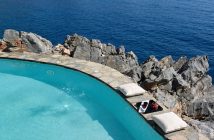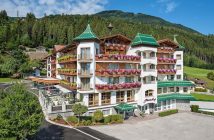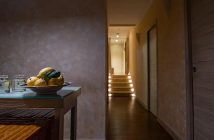A spot too much chocolate during the Easter festivities? Racked with guilt from the sugar and cocoa-fuelled overindulgence? Anna Selby travels to the purity of Puglia and goes positively Roman for the ultimate antidote…
Arriving at night, Borgo Egnazia is captivating. Near the coast right in the heel of Italy’s boot, this is Puglia’s finest. The creamy tufo limestone walls of La Corte (Court) rise magnificently, lit by huge church candles in giant lanterns. The main doors open on to a long hallway lined with more candles, white sofas, perfectly symmetrical pairs of open fires burning scented wood. With its curved ceilings, it looks like an old monastery and it has a sense of peace that wouldn’t be out of place there. But it was built in 2010. Adjoining La Corte is Il Borgo, a perfect medieval Italian village, complete with chapels, colonnades, bell towers and an open piazza (Justin Timberlake got married there). And this was built shortly after the main building.
So this is a place of both fantasy and vision. Except for its age, the traditional Italian architecture is totally authentic and it combines with a design that’s somehow both rustic and contemporary, based on symmetry and repetition – huge wicker baskets of walnuts or brown autumn leaves, branches suspended from the ceilings, suspending in turn old metal bird cages filled with candles, bundles of pages from old books, tied up with string in wooden frames as “pictures”, hayloft ladders leaning against the creamy walls, stone troughs full of rock salt. And an awful lot of candles.
Its spa, Vair, is equally inspired both in its design and its philosophy. So, forget the usual clinical whites. Here, the therapists wear flowing pleated robes in the spirit of the 3500-year-old Greek, later Roman, city whose ruins lie next to Borgo Egnazia. The spa is one of the most beautiful I have ever seen, all cream and honey stone, flickering candlelight, with the sound and reflections of moving water. The materials are stone, wood, wicker. The philosophy is to use only natural products, so if you have a pedicure there are no scissors or clippers. Your nails and skin are smoothed with salt, stone and wood, massaged with lemon and olive oil.
My spa journey begins, appropriately enough, with the Roman bath. I am introduced to my therapist, Antonella, who has swapped her flowing robe for a sarong made of thin towelling. We’re clearly in for a wet session. Now, there are many spas that claim a kind of hydrotherapy based on a Roman original but this bath-house is based on the one in the ruins down the road and it’s the closest you’re going to get to the Roman experience. For a start, you’re not left to wander around various hot and cold watery experiences. This bath works like a prescription and Antonella is the doctor. By the end, she promises highly beneficial results – stimulating the circulation and the immune system, conditioning the skin. In the meantime we have the place all to ourselves – no one will enter for the next two hours.
It begins with a slightly rude awakening. A cold shower is cunningly hidden among the archways and columns around the tepidarium and I walk through it twice holding my breath. Then Antonella leads me into the tepidarium (warm pool) itself and I sink onto an underwater massage bed and relax. This rhythm of hot and cold forms the basis of the entire experience. I go back under the cold shower and then it’s the sauna. “Not the usual sauna,” explains Antonella. “A little humidity, too.” She instructs me to lie down and gradually, imperceptibly the temperature increases from warm to sizzling hot.
I come out slightly light-headed and Antonella leads me to the other side of the tepidarium and points upwards. I see, hidden in the ceiling a wooden bucket. Yep, It’s cold water and it’s a lot more of a shock than a mere cold shower – it’s an icy deluge. By now I’m breathless rather than light headed and Antonella wraps me in warm towels and takes me to the caldarium (hot pool) and into just bearably hot water. Afterwards, I lie on the stone bed at the side of the pool, not sure whether it’s hotter in the water or out of it. Everything in here is hot – the floor, the bed, the walls. Then it’s back outside for a walk through an icy pool (thigh high) and back into the caldarium. Then back into the icy pool for a full – if momentary – immersion up to the shoulders. After a short final caldarium, I am wrapped in towels and lie on a wonderfully comfortable lounger while my body tries to work out what the temperature is. Candlelight flickers, water splashes and I’m almost asleep when Antonella comes to give me a foot massage.
After one last walk through the icy pool, we go to the treatment room where I am scrubbed with salt and sluiced down with ladles of warm water. Antonella then applies layer upon layer of waxy unguents, dark masks, rosemary and lavender waters to my – by now – entirely limp body. The last application is rose oil to my face. And then I’m done – the cleanest, most scented Roman of them all.
Later that afternoon, I meet Patrizia, the spa director who has designed most of the treatments herself and is clearly a woman of real passion when it comes to spas. It’s the Borgo Egnazia vision thing again and Patrizia has a free hand to explore way beyond the boundaries of most spas. She sees it as a way of unleashing potential rather than mere relaxation and has a course for women that runs over three days, “Taranta”, that includes ancient Puglian health traditions, yoga, psychology, circus arts, readings, massages, music therapy and “psycho-emotional experiences”. In this spa, detoxes combine with art therapy, yoga with facials, fitness with floatation. There is even a shaman, Stefano.
“It’s alchemy,” says Patrizia, “revolution. In this magical atmosphere, you can learn to relax and enjoy your life.” She suggests I try “psycho-aromatherapy” with her and presents a wooden box filled with complex aromatherapy blends. I tell her my reactions to them – whether I like or dislike them, sensations they evoke – and accordingly she draws a “tree” showing my psyche. It is an intense and fascinating process and she concludes that I’m ripe for revolution and transformation – maybe she’s right.
Certainly, what happens next is not what I was expecting. Patrizia takes me to the door of a studio and I go in to find a man dressed all in black (including a black hat) playing the violin. He is sitting on a stool and I go to sit on another stool opposite. Ropes hang along the walls and I wonder for a moment whether I’ve walked into 50 Shades of Grey or a warm-up for the Gypsy Kings. I just manage to suppress the giggles. After a while, he stops playing and starts singing, covering his face with his hat. Then he gets up and walks around the room singing and playing on a tambourine. He turns out to be Giuseppe – actor, musician, singer – and he guides me through an hour of singing (not something I often do in public and certainly not in Puglian dialect), Puglian-style dance, tambourine playing and a kind of fencing game, using your fingers rather than swords. It’s like being a child again and we spend a lot of time laughing. Laughing, it turns out, is the right thing to do. I discover later that the session, called “Astrignul” literally means “the giggles”.
It’s not all about the unexpected, though. Borgo Egnazia has more conventional treatments, too – facials, massages. They all, though, have a special Vair twist and, to be honest, are not like any I’ve previously had. My facial – “Abbel Bel” – is translated as “Slowly Slowly” and begins with my arms and hands massaged in a cool lotion, after which a few drops of liquid (oil? scented water?) fall on to the backs of my hands. Antonella (now dressed in her flowing gown) promises me beforehand, “This is very emotional,” and it isn’t just the Italian in her talking. This is partly because this facial is scent led. (Patrizia invented it, she told me, specially for herself.) The scents come in waves, held in front of your face on the therapist’s hands or falling in a gentle spray. They are all natural and Antonella showed me her tray of ingredients at the end. Instead of all the usual branded bottles and jars there were empty shells of squeezed lemons, sprigs of mint, rosemary, sage and lavender. The creams are all locally produced and based on pomegranate and almond oil. There are waters of rose and lavender. You do get lost in these scents – by turns, sweet, strange, delicious, stimulating – and drink them in like food for the soul. As the scents are gently pressed and massaged into the skin, you drift into dreams, memories, emotions.
And then there is the massage, “U Mor” (the sea). Almost all of the time, there is no background music in Vair, just the sound of moving water. This massage, though, is choreographed – and that really is the word – to a composition that includes the sound of the sea with a single female voice singing a wordless melody, like a mermaid sitting on the rocks. The massage (another invention of Patrizia’s) is slow and smooth, creating the feeling of the pull of the waves, contrasting currents, sand hollowing out beneath your head as the tide pulls it away.
Revolutionary? I’ll say. Transformational? Quite possibly. Beautiful? Definitely. This is a great spa. Just go.
Classic Collection Holidays (0800 294 9324; classic-collection.co.uk) offers 3 nights at Vair Spa, Borgo Egnazia, Puglia from £969 per person. Price based on 2 adults sharing a Corte Bella double room on a bed & breakfast basis, and includes return flights from London Gatwick (other UK departure airports available) to Bari and private transfers.




